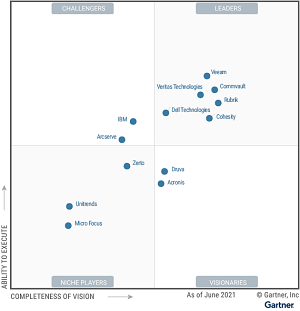News
In Age of Ransomware, Firm Lists Backup and Recovery Leaders: Veeam, Rubrik and Others
It's no surprise that research firm Gartner mentioned "ransomware" in the first sentence of its new Magic Quadrant report on Enterprise Backup and Recovery Software Solutions.
Ransomware is rampant right now, as a glimpse at the news will affirm, accounting for most malware attacks and leaving organizations in the lurch if they don't have a plan and are attacked.
The ransomware threat received more attention with the move to the public cloud, and that move -- along with other complexities -- caused infrastructure and operations (I&O) leaders to revamp their backup infrastructure and explore alternatives, Gartner said in the opening sentence of its new report.
"The recent increase in the number of ransomware attacks has resulted in vendors taking concrete steps toward providing ransomware detection and remediation as well as a resilient backup infrastructure," the report said. "While most vendors support the creation of immutable second copies of backup through write once, read many (WORM)-enabled storage, others such as IBM and Rubrik aim to make the primary backup repository more resilient by supporting immutable snapshots.
"Leading vendors are building capabilities to detect ransomware attacks by tracking large changes to file system data, and through other means, by partnering with security vendors or by developing these capabilities in-house. Most vendors also aim to simplify the ransomware recovery process through creation of an isolated test environment, and provide a clean backup copy to recover specific files. Such efforts remain largely a work in progress."
Those "leading vendors" in the Magic Quadrant report include Veeam, scoring highest on the "ability to execute" axis, and Rubrik, topping the "completeness of vision" scale. Others in the "Leaders" section were Commvault, Cohesity, Veritas Technologies and Dell Technologies.
 [Click on image for larger view.] Magic Quadrant for Enterprise Backup and Recovery Software Solutions (source: Gartner).
[Click on image for larger view.] Magic Quadrant for Enterprise Backup and Recovery Software Solutions (source: Gartner).
Gartner said that rather than focus on the enterprise backup and recovery software solution market as it is today, the report addresses transformational technologies or approaches delivering on future needs.
"Backup and recovery software solutions are designed to capture a point-in-time copy (backup) of an enterprise workload and write the data out to a secondary storage device for the purpose of recovering this data in case of loss," says the report, which lists the following core capabilities of backup and recovery solutions:
-
Back up and recover operating systems, files, databases and applications in the on-premises data center
-
Create a copy of the backup in the same physical location as the production environment for the purpose of quick operational recovery
-
Assign multiple backup and retention policies that align with the organization’s recovery objectives
-
Report success and failure of backup/recovery tasks
Along with those core capabilities, additional capabilities that can be provided include:
-
Create a second backup copy of on-premises backup data in the public cloud/secondary data center
-
Tier backup data to the public cloud
-
Protect public cloud IaaS, PaaS and SaaS workloads
-
Protect remote sites
The market has undergone much change in the past couple of years, the firm said, and vendors in the report focus on the following areas:
-
Centralized management
-
Ransomware resilience, detection and remediation
-
Support for public cloud IaaS and PaaS backup
-
Support for SaaS-based applications
-
Tiering to the public cloud
-
Recovery in the public cloud
-
NoSQL database backup
-
Instant recovery of databases and virtual machines
-
Container backup
-
Subscription licensing
The report, published last month, is available from several of the covered vendors in licensed-for-distribution copies. A simple web search for the name of the report will typically find such available free copies.
About the Author
David Ramel is an editor and writer at Converge 360.